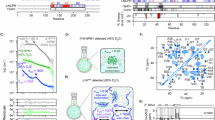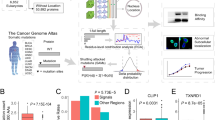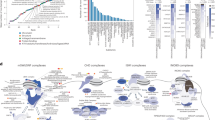Abstract
Fusion proteins containing the amino-terminal domain of human p14ARF linked to green fluorescent protein are able to bind MDM2 and stabilize p53 without localization in the nucleolus. However, these fusion proteins are inherently unstable, with half-lives considerably shorter than either authentic ARF or chimaeras containing the entire coding domain, both of which are predominantly nucleolar. We present evidence that the unstable fusion proteins are significantly stabilized if redirected to the nucleolus by addition of a basic motif based on the nuclear localization signal of SV40 T-antigen. Moreover, the stability of these proteins can be enhanced by modulating the functions of MDM2 and p53. These data are consistent with a model in which ARF interacts with MDM2 in the nucleoplasm but is consequently subject to proteasomal degradation. Nucleolar localization may serve to store or stabilize ARF.
This is a preview of subscription content, access via your institution
Access options
Subscribe to this journal
Receive 50 print issues and online access
$259.00 per year
only $5.18 per issue
Buy this article
- Purchase on SpringerLink
- Instant access to full article PDF
Prices may be subject to local taxes which are calculated during checkout







Similar content being viewed by others
References
Ashcroft M and Vousden KH . (1999). Oncogene, 18, 7637–7643.
Bates S, Phillips AC, Clark PA, Stott F, Peters G, Ludwig RL and Vousden KH . (1998). Nature, 395, 124–125.
Bothner B, Lewis WS, DiGiammarino EL, Weber JD, Bothner SJ and Kriwacki RW . (2001). J. Mol. Biol., 314, 263–277.
Clark PA, Llanos S and Peters G . (2002). Oncogene, 21, 4498–4507.
Datta B, Nag A and Raychaudhuri P . (2002). Mol. Cell. Biol., 22, 8398–8408.
David-Pfeuty T and Nouvian-Dooghe Y . (2002). Oncogene, 21, 6779–6790.
DeGregori J, Leone G, Miron A, Jakoi L and Nevins JR . (1997). Proc. Natl. Acad. Sci. USA, 94, 7245–7250.
Dimri GP, Itahana K, Acosta M and Campisi J . (2000). Mol. Cell. Biol., 20, 273–285.
Eymin B, Karayan L, Séité P, Brambilla C, Brambilla E, Larsen C-J and Gazzéri S . (2001). Oncogene, 20, 1033–1041.
Fang S, Jensen JP, Ludwig RL, Vousden KH and Weissman AM . (2000). J. Biol. Chem., 275, 8945–8951.
Fatyol K and Szalay AA . (2001). J. Biol. Chem., 276, 28421–28429.
Honda R, Tanaka H and Yasuda H . (1997). FEBS Lett., 420, 25–27.
Honda R and Yasuda H . (1999). EMBO J., 18, 22–27.
Honda R and Yasuda H . (2000). Oncogene, 19, 1473–1476.
Itahana K, Bhat KP, Jin A, Itahana Y, Hawke D, Kobayashi R and Zhang Y . (2003). Mol. Cell, 12, 1151–1164.
Jackson MW and Berberich SJ . (2000). Mol. Cell. Biol., 20, 1001–1007.
Jin Y, Lee H, Zeng SX, Dai M-S and Lu H . (2003). EMBO J., 22, 6365–6377.
Karayan L, Riou J-F, Séité P, Migeon J, Cantereau A and Larsen C-J . (2001). Oncogene, 20, 836–848.
Kim S-H, Mitchell M, Fujii H, Llanos S and Peters G . (2003). Proc. Natl. Acad. Sci. USA, 100, 211–216.
Korgaonkar C, Zhao L, Modestou M and Quelle DE . (2002). Mol. Cell. Biol., 22, 196–206.
Lin AW and Lowe SW . (2001). Proc. Natl. Acad. Sci. USA, 98, 5025–5030.
Lindström MS, Klangby U, Inoue R, Pisa P, Wiman KG and Asker CE . (2000). Exp. Cell. Res., 256, 400–410.
Llanos S, Clark PA, Rowe J and Peters G . (2001). Nat. Cell Biol., 3, 445–452.
Lohrum MAE, Ashcroft M, Kubbutat MHG and Vousden KH . (2000). Curr. Biol., 10, 539–542.
Martelli F, Hamilton T, Silver DP, Sharpless NE, Bardeesy N, Rokas M, DePinho RA, Livingston DM and Grossman SR . (2001). Proc. Natl. Acad. Sci. USA, 8, 4455–4460.
Midgley CA, Desterro JMP, Saville MK, Howard S, Sparks A, Hay RT and Lane DP . (2000). Oncogene, 19, 2312–2323.
Migliorini D, Danovi D, Colombo E, Carbone R, Pelicci PG and Marine J-C . (2002). J. Biol. Chem., 277, 7318–7323.
Orlowski M and Wilk S . (2003). Arch. Biochem. Biophys., 415, 1–5.
Parisi T, Pollice A, Di Cristofano A, Calabrò V and La Mantia G . (2002). Biochem. Biophys. Res. Commun., 291, 1138–1145.
Pomerantz J, Schreiber-Agus N, Liégeois NJ, Silverman A, Alland L, Chin L, Potes J, Chen K, Orlow I, Lee H-W, Cordon-Cardo C and DePinho RA . (1998). Cell, 92, 713–723.
Rizos H, Darmanian AP, Holland EA, Mann GJ and Kefford RF . (2001). J. Biol. Chem., 276, 41424–41434.
Rizos H, Darmanian AP, Mann GJ and Kefford RF . (2000). Oncogene, 19, 2978–2985.
Robertson KD and Jones PA . (1998). Mol. Cell. Biol., 18, 6457–6473.
Rubbi CP and Milner J . (2003). EMBO J., 22, 6068–6077.
Scheffner M, Huibregtse JM, Vierstra RD and Howley PM . (1993). Cell, 75, 495–505.
Sharpless NE and DePinho RA . (1999). Curr. Opin. Genet. Dev., 9, 22–30.
Sherr CJ . (2001). Nat. Rev., 2, 731–737.
Stott FJ, Bates S, James MC, McConnell BB, Starborg M, Brookes S, Palmero I, Hara E, Vousden KH and Peters G . (1998). EMBO J., 17, 5001–5014.
Sugimoto M, Kuo M-L, Roussel MF and Sherr CJ . (2003). Mol. Cell, 11, 415–424.
Tao W and Levine AJ . (1999). Proc. Natl. Acad. Sci. USA, 96, 6937–6941.
Verma R and Deshaies RJ . (2000). Cell, 101, 341–344.
Weber JD, Kuo M-L, Bothner B, DiGiammarino EL, Kriwacki RW, Roussel MF and Sherr CJ . (2000). Mol. Cell. Biol., 20, 2517–2528.
Weber JD, Taylor LJ, Roussel MF, Sherr CJ and Bar-Sagi D . (1999). Nat. Cell Biol., 1, 20–26.
Xirodimas D, Saville MK, Edling C, Lane DP and Lain S . (2001). Oncogene, 20, 4972–4983.
Zhang Y and Xiong Y . (1999). Mol. Cell, 3, 579–-591.
Zhang Y, Xiong Y and Yarbrough WG . (1998). Cell, 92, 725–734.
Acknowledgements
We are grateful to Domenico Migliorini for providing MDMX plasmids and to Takashi Toda and Giampietro Schiavo for comments on the manuscript.
Author information
Authors and Affiliations
Corresponding author
Rights and permissions
About this article
Cite this article
Rodway, H., Llanos, S., Rowe, J. et al. Stability of nucleolar versus non-nucleolar forms of human p14ARF. Oncogene 23, 6186–6192 (2004). https://doi.org/10.1038/sj.onc.1207854
Received:
Revised:
Accepted:
Published:
Issue date:
DOI: https://doi.org/10.1038/sj.onc.1207854
Keywords
This article is cited by
-
PKC Dependent p14ARF Phosphorylation on Threonine 8 Drives Cell Proliferation
Scientific Reports (2018)
-
Siva1 inhibits p53 function by acting as an ARF E3 ubiquitin ligase
Nature Communications (2013)
-
Nucleophosmin and its complex network: a possible therapeutic target in hematological diseases
Oncogene (2011)
-
Binding to nucleophosmin determines the localization of human and chicken ARF but not its impact on p53
Oncogene (2008)
-
TBP-1 protects the human oncosuppressor p14ARF from proteasomal degradation
Oncogene (2007)



